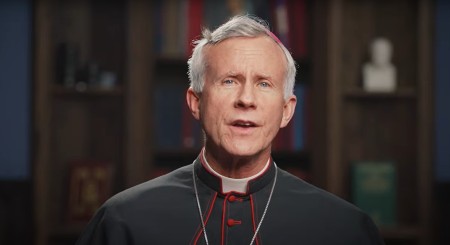 Dear readers, Catholic Online was de-platformed by Shopify for our pro-life beliefs. They shut down our Catholic Online, Catholic Online School, Prayer Candles, and Catholic Online Learning Resources—essential faith tools serving over 1.4 million students and millions of families worldwide. Our founders, now in their 70's, just gave their entire life savings to protect this mission. But fewer than 2% of readers donate. If everyone gave just $5, the cost of a coffee, we could rebuild stronger and keep Catholic education free for all. Stand with us in faith. Thank you. Help Now >
Dear readers, Catholic Online was de-platformed by Shopify for our pro-life beliefs. They shut down our Catholic Online, Catholic Online School, Prayer Candles, and Catholic Online Learning Resources—essential faith tools serving over 1.4 million students and millions of families worldwide. Our founders, now in their 70's, just gave their entire life savings to protect this mission. But fewer than 2% of readers donate. If everyone gave just $5, the cost of a coffee, we could rebuild stronger and keep Catholic education free for all. Stand with us in faith. Thank you. Help Now >
With Your Spirit: Happy Priest on Preparing for the New Translation of the Mass
FREE Catholic Classes
At the root of our present liturgical crisis within the ordinary form of the Roman Rite is not the form in and of itself, but the negation that there is an essential difference between the common priesthood of the faithful and the ministerial priesthood. "And with your spirit" authentically expresses in human language this essential difference. We need to understand with precision that the liturgical assembly is comprised of two essentially different groups of people: the common priesthood of the faithful and the ministerial priesthood. Both have different functions within the liturgical assembly. Each is a form of participation in the mystery.
Highlights
Catholic Online (https://www.catholic.org)
11/15/2010 (1 decade ago)
Published in Living Faith
Keywords: Mass, Roman Missal, Liturgy, GIRM, Holy Mass, Eucharist, Catholic, Rome
P align=justify>CORPUS CHRISTI, TX (Catholic Online) - I am very excited that the new English translation of the ordinary form of the Roman Rite Catholic Mass will go into effect on the First Sunday of Advent 2011.
After having discussed important background information on this topic, let us begin to take a closer look at the actual changes that will take place.
Perhaps the biggest change that people will have to get accustomed to is the use of the literal translation of "Et cum spiritu tuo." Currently the priest says: "The Lord be with you" and the people respond: "And also with you." With the new translation, the response is: "And with your spirit."
Jeffrey Pinyan, in his excellent book Praying the Mass: the Prayers of the People, points out that English is the only major language of the Roman Rite that did not translate the Latin word spiritu. For example, the Spanish "Y con tu espiritu" is a precise translation of the Latin text.
Why is the difference between "with you" and "with your spirit" so crucial?
The literal translation of "Et cum spiritu tuo" as "And with your spirit" expresses precisely the essential difference between the priesthood of the faithful and the ministerial priesthood.
The Vatican II document The Dogmatic Constitution on the Church Lumen Gentium repeats and affirms the teaching of the Council of Trent when it states: "Though they differ from one another in essence and not only in degree, the common priesthood of the faithful and the ministerial or hierarchical priesthood are nonetheless interrelated: each of them in its own special way is a participation in the one priesthood of Christ."
"The ministerial priest, by the sacred power he enjoys, teaches and rules the priestly people; acting in the person of Christ, he makes present the Eucharistic sacrifice and offers it to God in the name of all the people. But the faithful, in virtue of their royal priesthood, join in the offering of the Eucharist. They likewise exercise that priesthood in receiving the sacraments, in prayer and thanksgiving, in the witness of a holy life, and by self-denial and active charity" (II, 10).
We need to understand with precision that the liturgical assembly is comprised of two essentially different groups of people: the common priesthood of the faithful and the ministerial priesthood. Both have different functions within the liturgical assembly. In order for our liturgical celebrations to be an authentic expression of our Catholic Faith, it is vital for each member of the assembly to understand who they are so that they can do what they are supposed to do.
At the root of our present liturgical crisis within the ordinary form of the Roman Rite is not the form in and of itself, but the negation that there is an essential difference between the common priesthood of the faithful and the ministerial priesthood. "And with your spirit" authentically expresses in human language this essential difference.
Cardinal Francis George, OMI explained the importance of "And with your spirit" when he said: "Our current translation might seem more personal and friendly, but that's the problem. The spirit referred to in the Latin is the spirit of Christ that comes to a priest when he is ordained, as St. Paul explained to St. Timothy. In other words, the people are saying in their response that Christ as head of the Church is the head of the liturgical assembly, no matter who the particular priest celebrant may be. That is a statement of faith, a statement distorted by transforming it in an exchange of personal greetings."
Lex orandi, lex credendi (what we pray is what we believe) and Lex credendi, lex orandi (what we believe is what we pray) is an essential principle to keep in mind as we prepare ourselves to embrace the new translation of the ordinary form of the Roman Rite.
The emphasisand clarity concerning the essential difference between the common priesthood of the faithful and the ministerial priesthood is carried further in the Offertory with the correct translation of the Latin "meum ac vestrum sacrificium".
Currently the priest says: "Pray brethren that our sacrifice may be acceptable to God, the Almighty Father." The correct translation of the Latin is: "Pray brethren that my sacrifice and yours may be acceptable to God, the Almighty Father."
However, let us continue this important discussion in my next article.
------------------------------------------------
Father James Farfaglia, the Happy Priest, is the pastor of Saint Helena of the True Cross of Jesus Catholic Church in Corpus Christi, Texas. Father has a hard hitting blog called Illegitimi non carborundum. He has also published a book called Man to Man: A Real Priest Speaks to Real Men about Marriage, Sexuality and Family Life. You can contact Father at fjficthus@gmail.com.
---
'Help Give every Student and Teacher FREE resources for a world-class Moral Catholic Education'
Copyright 2021 - Distributed by Catholic Online
Join the Movement
When you sign up below, you don't just join an email list - you're joining an entire movement for Free world class Catholic education.
-

-
Mysteries of the Rosary
-
St. Faustina Kowalska
-
Litany of the Blessed Virgin Mary
-
Saint of the Day for Wednesday, Oct 4th, 2023
-
Popular Saints
-
St. Francis of Assisi
-
Bible
-
Female / Women Saints
-
7 Morning Prayers you need to get your day started with God
-
Litany of the Blessed Virgin Mary
5 Biblical Warnings We All Must Heed
-

WHAT WILL IT TAKE? | Bishop Strickland Calls Out Silent Bishops in Strong Public Letter
-

Giants of the Fallen: Unveiling the Mystery of the Nephilim from a Catholic Perspective
-
Ancient Wisdom, Modern Choices: How Ecclesiastes 10:2 Illuminates Today's Political Divide
-
How Do We Know Truth? A Catholic Perspective
Daily Catholic
 Daily Readings for Sunday, November 17, 2024
Daily Readings for Sunday, November 17, 2024 St. Elizabeth of Hungary: Saint of the Day for Sunday, November 17, 2024
St. Elizabeth of Hungary: Saint of the Day for Sunday, November 17, 2024 Prayer to Saint Anthony of Padua, Performer of Miracles: Prayer of the Day for Sunday, November 17, 2024
Prayer to Saint Anthony of Padua, Performer of Miracles: Prayer of the Day for Sunday, November 17, 2024- Daily Readings for Saturday, November 16, 2024
- St. Hugh of Lincoln: Saint of the Day for Sunday, November 17, 2024
- Prayer for Life: Prayer of the Day for Saturday, November 16, 2024
![]()
Copyright 2024 Catholic Online. All materials contained on this site, whether written, audible or visual are the exclusive property of Catholic Online and are protected under U.S. and International copyright laws, © Copyright 2024 Catholic Online. Any unauthorized use, without prior written consent of Catholic Online is strictly forbidden and prohibited.
Catholic Online is a Project of Your Catholic Voice Foundation, a Not-for-Profit Corporation. Your Catholic Voice Foundation has been granted a recognition of tax exemption under Section 501(c)(3) of the Internal Revenue Code. Federal Tax Identification Number: 81-0596847. Your gift is tax-deductible as allowed by law.






 Daily Readings for Sunday, November 17, 2024
Daily Readings for Sunday, November 17, 2024 St. Elizabeth of Hungary: Saint of the Day for Sunday, November 17, 2024
St. Elizabeth of Hungary: Saint of the Day for Sunday, November 17, 2024 Prayer to Saint Anthony of Padua, Performer of Miracles: Prayer of the Day for Sunday, November 17, 2024
Prayer to Saint Anthony of Padua, Performer of Miracles: Prayer of the Day for Sunday, November 17, 2024

